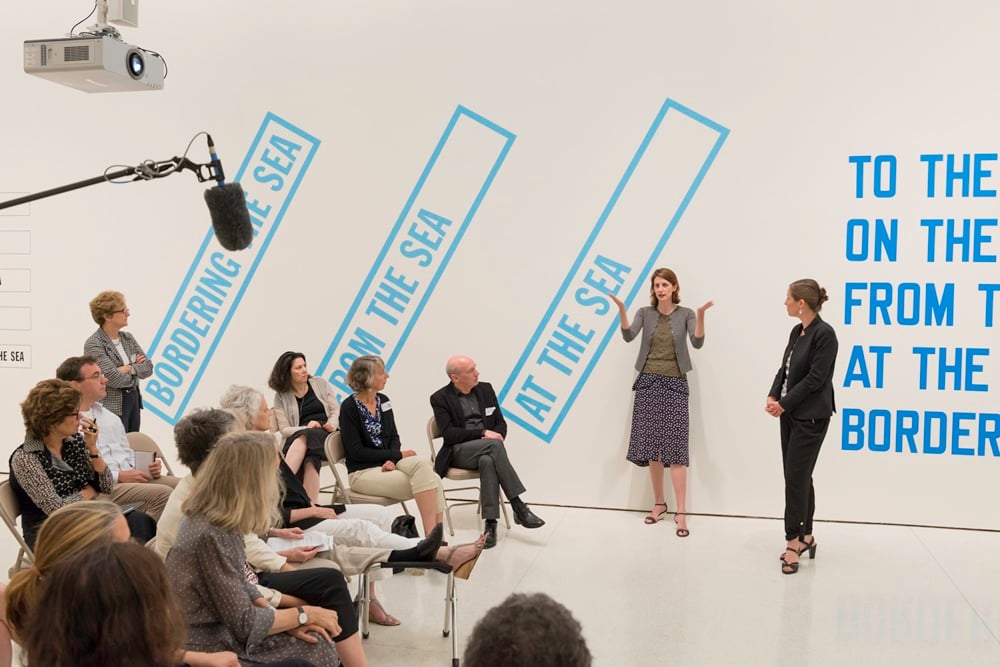Every Monday morning, artnet News brings you The Gray Market. The column decodes important stories from the previous week—and offers unparalleled insight into the inner workings of the art industry in the process.
This week, a wrestling match between academia and economics…
PANZA-MONIUM
On Monday, Andy Battaglia of ARTnews dug into the aesthetic and philosophical briar patch surrounding “Object Lessons: The Panza Collective Initiative Symposium” at the Solomon R. Guggenheim Museum. Held this past Tuesday and Wednesday, the program consisted of a series of talks on key Minimalist, Post-Minimalist, and conceptual works acquired by the museum in the early 1990s from Italian super-collector Giuseppe Panza di Biumo.
It’s a fascinatingly wild read from an academic standpoint. I’d just also like to add that it carries plenty of weighty implications for the market side of these genres, too.
For context, the symposium was only the latest entry in the larger Panza Collective Initiative (PCI), a three-phase, nearly decade-long research expedition made possible by multiple grants from the Andrew W. Mellon Foundation. Originally launched in 2010, the PCI’s ultimate goal is to resolve, or at least drastically clarify, the many complexities surrounding roughly 350 important 1960s and ’70s works that the Guggenheim acquired from Panza, including dozens of pieces by Dan Flavin, Donald Judd, Bruce Nauman, Robert Morris, and Lawrence Weiner.

Conservator Francesca Esmay (second from right) discusses Lawrence Weiner’s work, which was installed for study during the Panza Collection Initiative Advisory Committee meeting, July 2013. Photo: David Heald © The Solomon R. Guggenheim Foundation
Those works also feature more complications than delivering a baby in the back of a moving car. Central to the PCI are numerous quandaries raised by artists who explored outsourced fabrication, the use of eminently replaceable (and often highly degradable) materials, and works comprised entirely of instructions or diagrams—all before those practices became everyday aspects of contemporary art.
These questions are made even more thorny by the fact that Panza often entered into unorthodox arrangements with artists and sometimes even took the liberty to fabricate unrealized works without their say-so or supervision.
As a case in point, Battaglia asks us to consider two conflicting iterations of the same edition of Flavin’s Untitled (to Henri Matisse) received by the Guggenheim from Panza. Against Flavin’s direct instructions, the 1964 version was never destroyed after the studio authorized a 1995 replacement using sleeker fixtures and brighter bulbs—a fact that, on some level, unloads on the Guggenheim the task of figuring out how to responsibly reconcile the artist’s intentions and the art-historical reality.
The symposium sought to answer a number of questions related to puzzles like these: Which version(s) should be considered “authentic”? Does the museum have a responsibility to preserve both, even if the scholarly consensus holds that one or the other is problematic? And what happens if, say, physical deterioration of the “authentic” iteration(s) eventually compels the Guggenheim and Flavin’s foundation to conclude that the existing version(s) should be replaced again?
Given how wonky this all gets, I appreciate the self-awareness of curator Jeffrey Weiss, one of the pivotal figures in the PCI, during this exchange with Battaglia:
Another important question to keep in mind, Weiss said: “How much does it matter?” Speaking with a mix of excitement and exasperation over the complexities at hand, he said, “We have to always be self-critical and ask ourselves whether or not we’re getting too lost in the weeds.”
Weiss’s caveat is definitely legitimate when it comes to the concerns of the average museum visitor. But based on firsthand experience in my gallery days, I can tell you that there are two groups that these questions matter to very, very much: dealers and connoisseur collectors of works like the ones under review in the PCI. Because there is a lot of money riding on the answers.

Conservator Francesca Esmay (left) presents two different fabrications of Dan Flavin’s untitled (to Henri Matisse) (1964), which were installed for study during the Panza Collection Initiative Advisory Committee meeting, July 2011. Photo: Kristopher McKay © The Solomon R. Guggenheim Foundation
COMMON AND UNCOMMON SENSE
Here’s the thing about the market for Minimalist and Post-Minimalist works: It’s nearly impossible to sell one if you can’t definitively tell an interested client how many others like it are out there, whether the one you’re offering has ever been re-fabricated or updated, and how they can go about repairing or replacing it if necessary without violating the artist’s wishes.
Furthermore, assuming the condition of each is comparable, pieces made up of older components are likely to be appraised as more valuable than ones in which components have been replaced—even when the artists conceived and executed the works on the premise that the age of the physical components is irrelevant!
Why? The first point is all about uncertainty. For instance, no one wants to buy a work they’re told is unique only for later research to reveal—surprise!—it’s actually a less scarce (and thus, less valuable) edition of five. The second point is all about mythology: the decades-older components were nearer to the hallowed beginning of the artist’s evolution, and thus (at least according to a prospective buyer) embedded deeper in their mythos.
In my gallery career, I saw deals for Minimalist works come together—and fall apart—largely based on answers to questions like these. But you don’t have to take my word for it. Some of the same issues now consuming the PCI arose in a 2013 New Yorker profile of David Zwirner, who successfully poached the Flavin estate from Paula Cooper in 2008. The piece highlights the controversy that ensued afterward, when the estate decided to begin completing editions of Flavin’s light works that had not yet been fabricated by the time of his death—and which Cooper, Pace, and other owners of the existing editions all understood would never be made (and presumably priced accordingly).
Aside from the scarcity question, though, Cooper also speaks to the counterintuitive value proposition of original components in Flavin’s designed-to-be-replaceable works. Excerpt time!
Sometimes the fluorescent tubes burn out and need to be replaced. As it happens, to get new ones, you have to order them through David Zwirner, who orders them in bulk from the same manufacturer that made them during Flavin’s lifetime. “A lot of us who worked with Flavin still have the old bulbs,” Cooper said, with a sly smile. You got the feeling that someone would soon be making a market in those, too.
In the end, it’s essentially a new-money-versus-old-money argument. (In the same piece, Cooper also laments that “most new collectors don’t care or know any better” than to value Flavin’s works differently based on whether their certificates of authenticity are signed by Flavin himself or, posthumously, by the estate.)
So while part of the Panza Collection Initiative corresponds to very common-sense trade questions about knowing what you’re getting, another part relates back to connoisseur collectors’ fetish for mythology, even when the myths run counter to the artist’s instructions—or even philosophy. And regardless of the PCI’s academic conclusions about Flavin and other like-minded late artists of his era, expect the latter trait of the market to live on.
That’s all for this week. ‘Til next time, remember: where there’s a will to manufacture value, there’s a way.
[ARTnews]







